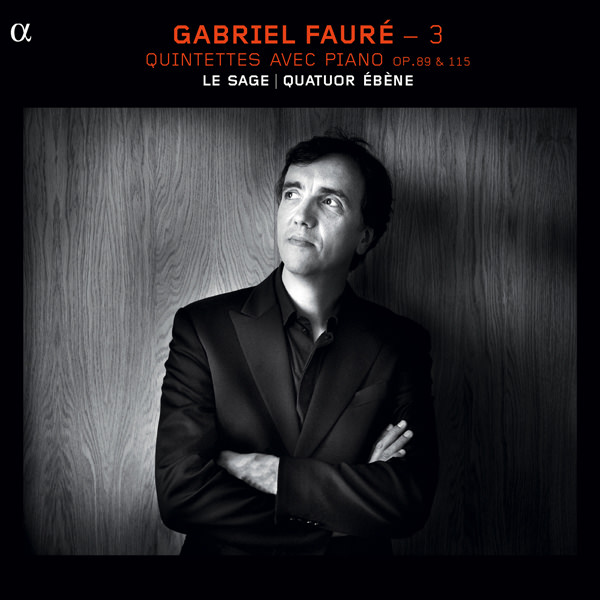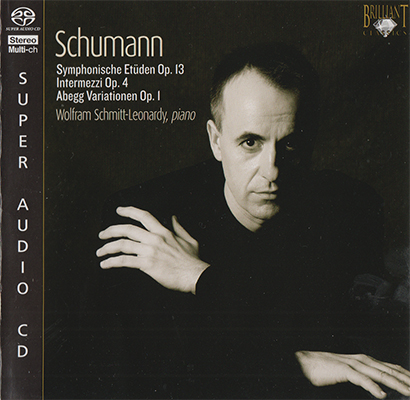
Gabriel Faure Vol. 3: Piano Quintets, op. 89 & 115 – Eric Le Sage, Quatuor Ebene (2012)
FLAC (tracks) 24-bit/88,2 kHz | Time – 01:06:11 minutes | 1,08 GB | Genre: Classical
Studio Master, Official Digital Download – Source: Qobuz | Booklet, Front Cover | © Alpha Classics / Outhere Music
In a genre set by Boccherini and represented in the nineteenth century by the masterpieces of Schumann, Brahms and Franck, Gabriel Fauré composed two scores that were very different from his early romances and the evanescent ‘lullaby ofdeath’ that is the Requiem. The Piano Quintet op. 89 remains little known, for reasons related to its composition as much as to its history. Regarded by Koechlin a some of Fauré’s finest work, it serves as a transition to the composer’s final stylistic period. Opus 115, surprisingly less melancholy than its predecessor, is one ofthe composer’s last productions. In the evening of his life Faure demonstrated his supreme mastery and prodigious creative power, giving French chamber music, which he served so well, one of its finest monuments.
Eric Le Sage continues his Fauré exploration (I much liked the piano quartets – 10/12) with the two quintets. Both are late masterpieces, the Second the more approachable of the two, while the First stands on the cusp of middle and late and abounds in constantly shifting tonal centres and melodies that seem to slip, ungraspably, through your fingers. This is the most fragile of musical discourses, so easily wounded if the performers aren’t completely at one with the idiom. In that respect, the Ebène Quartet are, of course, past masters. In fact, this recording was made just weeks after their contributions to Virgin’s Fauré box (with two different pianists: Michel Dalberto in No 1 and Nicholas Angelich in No 2). That was one of the more successful discs in a distinctly mixed bag that was on the whole compromised by the recording quality.
Comparison is fascinating. Unsurprisingly, the performances don’t differ markedly in terms of tempo or interpretation, but the devil’s in the detail, and this is where this set wins out time and again. The most obvious plus is that the recording itself has more clarity and you’re more aware of the individual string players, a particular delight in the case of this fab four.
The opening of the Second Quintet’s Allegro vivo is more withdrawn than elsewhere, without compromising on its thrilling momentum. And the slow movement comes off better, too, largely because the pianist is more integrated into the texture; in solemnity they give the London Bridge Ensemble a run for their money. Le Sage offers consistently limpid playing, so unmistakably French, whether in the many passages of virtuoso writing – sample the way he sets the scene in the opening movement of No 1 – or in the bell-like pealing of the finale of the same work. Everywhere the pacing sounds utterly natural: Le Sage and the Ebène are the most persuasive guides through sometimes daunting terrain. This is a clear front-runner in this repertoire. -Harriet Smith, Gramophone
Tracklist:
Gabriel Fauré (1845-1924)
Premier Quintette Op.89
1 I – Molto moderato 11’59
2 II – Adagio 11’26
3 III – Allegretto moderato 8’05
Deuxième Quintette Op.115
4 I – Allegro moderato 11’25
5 II – Allegro vivo 3’57
6 III – Andante moderato 12’35
7 IV – Allegro molto 6’10
Personnel:
Éric Le Sage, piano
Pierre Colombet, violon 1,
Gabriel Le Magadure, violon 2
Mathieu Herzog, alto
Raphaël Merlin, violoncelle
Download:
mqs.link_GabrielFaurVl.3EricLeSageQuaturbne2012Qbuz24882.part1.rar
mqs.link_GabrielFaurVl.3EricLeSageQuaturbne2012Qbuz24882.part2.rar




















![Eric Le Sage - Brahms: Œuvres pour piano à quatre mains (Intégrale musique de chambre), Vol. 10 (2022) [FLAC 24bit/96kHz] Eric Le Sage - Brahms: Œuvres pour piano à quatre mains (Intégrale musique de chambre), Vol. 10 (2022) [FLAC 24bit/96kHz]](https://imghd.xyz/images/2022/07/04/ciczdpp6i5ndc_600.jpg)
![Eric Le Sage - Jardins suspendus (2022) [FLAC 24bit/96kHz] Eric Le Sage - Jardins suspendus (2022) [FLAC 24bit/96kHz]](https://imghd.xyz/images/2022/11/27/ul29tux7wlwgb_600.jpg)
![St Salvator’s Chapel Choir - Resonances of Waterloo (2018) [FLAC 24bit/96kHz] St Salvator’s Chapel Choir - Resonances of Waterloo (2018) [FLAC 24bit/96kHz]](https://getimg.link/images/imgimgimg/uploads/2019/05/EF4mE00.jpg)
![Eric Le Sage, Daishin Kashimoto - Concert de Chausson - Quintette de Vierne (2024) [FLAC 24bit/192kHz] Eric Le Sage, Daishin Kashimoto - Concert de Chausson - Quintette de Vierne (2024) [FLAC 24bit/192kHz]](https://imghd.xyz/images/2024/09/28/7680aa6f62c5410a8fef964552e281e8-694008331889559551.webp)
![Gabriel Faure Vol. 1: Works for cello and piano & trio Op. 120 - Eric Le Sage, Francois Salque, Paul Meyer (2011) [Qobuz FLAC 24bit/88,2kHz] Gabriel Faure Vol. 1: Works for cello and piano & trio Op. 120 - Eric Le Sage, Francois Salque, Paul Meyer (2011) [Qobuz FLAC 24bit/88,2kHz]](https://getimg.link/images/imgimgimg/uploads/2018/02/aQp0jL1.jpg)
![Maurizio Baglini - Schumann: Kreisleriana, Davidsbundlertanze, Kinderszenen (2018) [FLAC 24bit/96kHz] Maurizio Baglini - Schumann: Kreisleriana, Davidsbundlertanze, Kinderszenen (2018) [FLAC 24bit/96kHz]](https://getimg.link/images/imgimgimg/uploads/2018/06/3s0Ucl9.jpg)
![Marco Schiavo & Sergio Marchegiani - Brahms: Hungarian Dances - Waltzes, Op. 39 (2018) [FLAC 24bit/96kHz] Marco Schiavo & Sergio Marchegiani - Brahms: Hungarian Dances - Waltzes, Op. 39 (2018) [FLAC 24bit/96kHz]](https://getimg.link/images/imgimgimg/uploads/2019/12/UGss5XE.jpg)
![Antonin Dvorak: Requiem, Op. 89 (2014) [Blu-Ray Pure Audio Disc + FLAC 24bit/96kHz] Antonin Dvorak: Requiem, Op. 89 (2014) [Blu-Ray Pure Audio Disc + FLAC 24bit/96kHz]](https://getimg.link/images/imgimgimg/uploads/2015/09/CsPgxIx.jpg)
![Lorin Maazel - Britten: War Requiem (2017) [Qobuz FLAC 24bit/44,1kHz] Lorin Maazel - Britten: War Requiem (2017) [Qobuz FLAC 24bit/44,1kHz]](https://getimg.link/images/imgimgimg/uploads/2017/11/blmrap4.jpg)
![Bach Choir, London Symphony Chorus, London Symphony Orchestra & Benjamin Britten - Britten: War Requiem (1963/2013) [FLAC 24bit/96kHz] Bach Choir, London Symphony Chorus, London Symphony Orchestra & Benjamin Britten - Britten: War Requiem (1963/2013) [FLAC 24bit/96kHz]](https://getimg.link/images/imgimgimg/uploads/2019/11/ICdCUfg.jpg)

![Oxford Baroque, Christ Church Cathedral Choir & Stephen Darlington - Francesco Durante: Requiem (2016) [Qobuz FLAC 24bit/96kHz] Oxford Baroque, Christ Church Cathedral Choir & Stephen Darlington - Francesco Durante: Requiem (2016) [Qobuz FLAC 24bit/96kHz]](https://getimg.link/images/imgimgimg/uploads/2019/07/4DLXZj3.jpg)
![London Symphony Orchestra, Gianandrea Noseda - Verdi: Requiem (1874) (2016) [FLAC 24bit/96kHz] London Symphony Orchestra, Gianandrea Noseda - Verdi: Requiem (1874) (2016) [FLAC 24bit/96kHz]](https://getimg.link/images/imgimgimg/uploads/2019/01/6VMV0BH.jpg)
![Emmanuel Pahud, Eric Le Sage - Romances (2023) [FLAC 24bit/96kHz] Emmanuel Pahud, Eric Le Sage - Romances (2023) [FLAC 24bit/96kHz]](https://imghd.xyz/images/2023/06/15/x1u7izwh0vruc_600.jpg)
![Gabriel Faure Vol. 2: Piano Quartets, op. 15 & 45 - Eric Le Sage, Daishin Kashimoto, Lise Berthaud, Francois Salque (2012) [Qobuz FLAC 24bit/88,2kHz] Gabriel Faure Vol. 2: Piano Quartets, op. 15 & 45 - Eric Le Sage, Daishin Kashimoto, Lise Berthaud, Francois Salque (2012) [Qobuz FLAC 24bit/88,2kHz]](https://getimg.link/images/imgimgimg/uploads/2018/02/SUCTlKI.jpg)